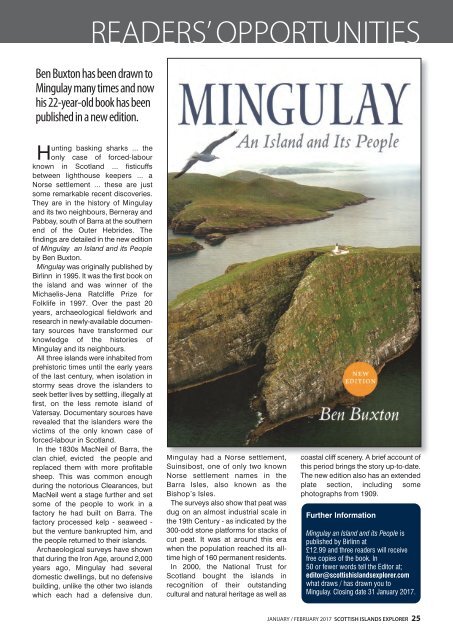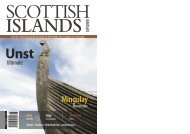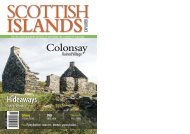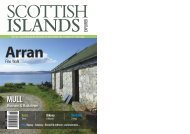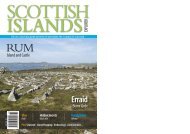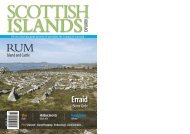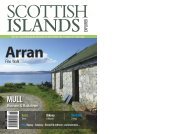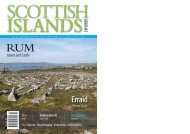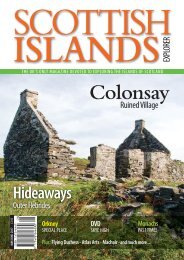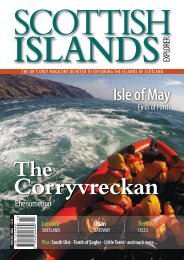You also want an ePaper? Increase the reach of your titles
YUMPU automatically turns print PDFs into web optimized ePapers that Google loves.
READERS’ OPPORTUNITIES<br />
Page Index Header<br />
Ben Buxton has been drawn to<br />
Mingulay many times and now<br />
his 22-year-old book has been<br />
published in a new edition.<br />
Hunting basking sharks ... the<br />
only case of forced-labour<br />
known in Scotland ... fisticuffs<br />
between lighthouse keepers ... a<br />
Norse settlement ... these are just<br />
some remarkable recent discoveries.<br />
They are in the history of Mingulay<br />
and its two neighbours, Berneray and<br />
Pabbay, south of Barra at the southern<br />
end of the Outer Hebrides. The<br />
findings are detailed in the new edition<br />
of Mingulay an Island and its People<br />
by Ben Buxton.<br />
Mingulay was originally published by<br />
Birlinn in 1995. It was the first book on<br />
the island and was winner of the<br />
Michaelis-Jena Ratcliffe Prize for<br />
Folklife in 1997. Over the past 20<br />
years, archaeological fieldwork and<br />
research in newly-available documentary<br />
sources have transformed our<br />
knowledge of the histories of<br />
Mingulay and its neighbours.<br />
All three islands were inhabited from<br />
prehistoric times until the early years<br />
of the last century, when isolation in<br />
stormy seas drove the islanders to<br />
seek better lives by settling, illegally at<br />
first, on the less remote island of<br />
Vatersay. Documentary sources have<br />
revealed that the islanders were the<br />
victims of the only known case of<br />
forced-labour in Scotland.<br />
In the 1830s MacNeil of Barra, the<br />
clan chief, evicted the people and<br />
replaced them with more profitable<br />
sheep. This was common enough<br />
during the notorious Clearances, but<br />
MacNeil went a stage further and set<br />
some of the people to work in a<br />
factory he had built on Barra. The<br />
factory processed kelp - seaweed -<br />
but the venture bankrupted him, and<br />
the people returned to their islands.<br />
Archaeological surveys have shown<br />
that during the Iron Age, around 2,000<br />
years ago, Mingulay had several<br />
domestic dwellings, but no defensive<br />
building, unlike the other two islands<br />
which each had a defensive dun.<br />
Mingulay had a Norse settlement,<br />
Suinsibost, one of only two known<br />
Norse settlement names in the<br />
Barra Isles, also known as the<br />
Bishop’s Isles.<br />
The surveys also show that peat was<br />
dug on an almost industrial scale in<br />
the 19th Century - as indicated by the<br />
300-odd stone platforms for stacks of<br />
cut peat. It was at around this era<br />
when the population reached its alltime<br />
high of 160 permanent residents.<br />
In 2000, the National Trust for<br />
Scotland bought the islands in<br />
recognition of their outstanding<br />
cultural and natural heritage as well as<br />
coastal cliff scenery. A brief account of<br />
this period brings the story up-to-date.<br />
The new edition also has an extended<br />
plate section, including some<br />
photographs from 1909.<br />
Further Information<br />
Mingulay an Island and its People is<br />
published by Birlinn at<br />
£12.99 and three readers will receive<br />
free copies of the book. In<br />
50 or fewer words tell the Editor at;<br />
editor@scottishislandsexplorer.com<br />
what draws / has drawn you to<br />
Mingulay. Closing date 31 <strong>Jan</strong>uary <strong>2017</strong>.<br />
JANUARY / FEBRUARY <strong>2017</strong> SCOTTISH ISLANDS EXPLORER 25


